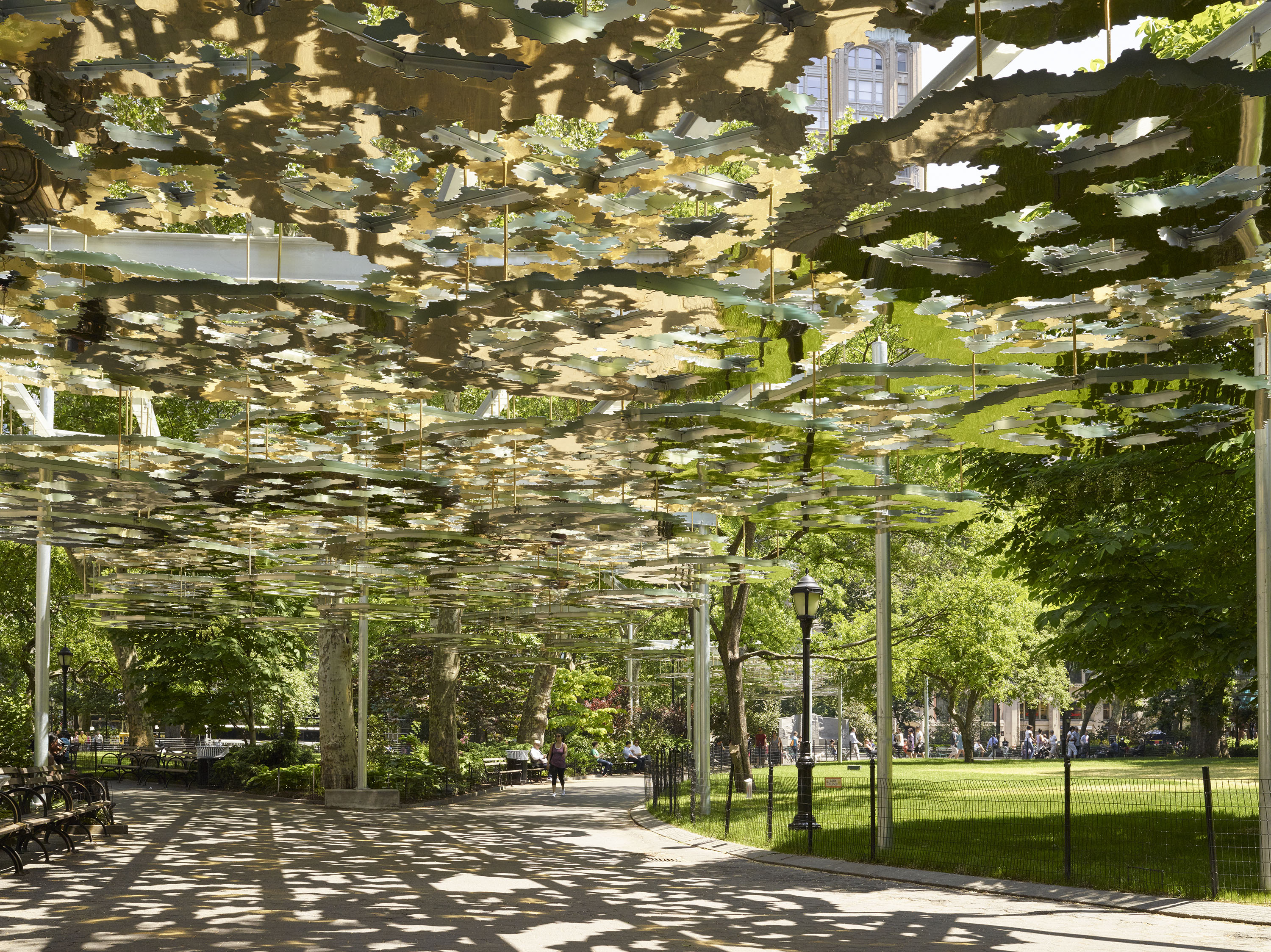
Fata Morgana, 2015. Installation view. Madision Square Park, New York
2015-2016. © Teresita Fernández. Photo: Elisabeth Bernstein. Courtesy of the artist, Lehmann Maupin, New York and Hong Kong, and Anthony Meier Fine Arts, San Francisco.
Through her sculptures, drawings, and installations, artist Teresita Fernández consistently expands the definition of landscape, moving notions of place into a conceptual realm that both seduces and challenges the viewer. The question Where am I? swells into What happened here?, Who has been here before me?, alongside the more metaphysical How does my presence define this place and my experience of it?
Lindsey Davis: You’ve said that the word “landscape” is often lazily used. I see your work as creating sculptural landscapes, one with an emphasis on LAND and a ‘scape that requires bodies move in and around it. How do you see your work utilizing traditional notions of landscape, and how do you see it working against those same notions?
Teresita Fernández: I cull from a lot of established ideas of landscape, but I’m also questioning them and trying to provide a very different series of lenses to amplify what the word “landscape” means. And so, when I say it’s used in a lazy way, it means that, especially for the West, we use that word to pretty much mean a traditional pictorial representation that comes from European landscape painting and/or American landscape painting. And so that’s a very limited notion of what the idea of landscape is, especially if you look at non-Western traditions—and not just traditions, but conceptualizations of what place and landscape are. It’s an entirely different language, and an entirely different set of reference points to understand this idea of place and one’s own placement as an extension.
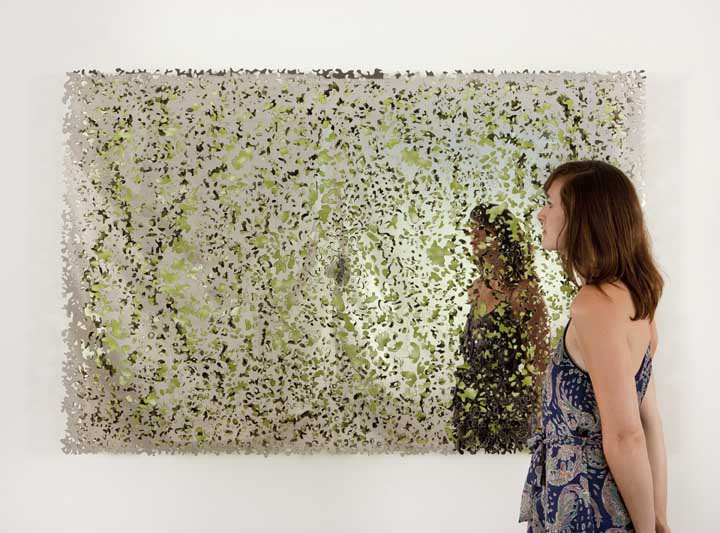
Blind Land (Green Mirror), 2013. Two layers of polished precision-cut stainless steel, 46.5 x 70.5 inches. Courtesy the artist, and Lehmann Maupin, New York and Hong Kong.
LD: The anthropomorphism in your sculptures seems to give your work a fantastical feeling—as if they’re from another planet similar to ours, or that our world’s elements are being seen through a prism of understated elegance. Is there a particular place you hope your work transports viewers to, or a particular feeling you hope it gives them?
TF: More than a particular feeling, the reaction that I value most in the viewer is one of intimacy. If you think of places that you have a connection to, you have a very subjective and a very personal intimacy with those places.
What I’m asking is “where am I? How does this place exist in our collective imagination?” In this way, landscape comes to mean a totally constructed notion that’s very far away from whatever physical vista is in front of you.
That sense of intimacy is, I think, what’s transportive. It’s an idea linked to phenomenology that’s about, for lack of a better word, a kind of significant daydreaming. It’s about projecting yourself onto something, and moving through a space without necessarily physically moving through it. It’s a different way of inhabiting a place, or another aspect, let’s say, of inhabiting a place. And the anthropomorphism really has to do with one’s body in relation to place. I’ve made works that are literally references to the body, for example, I made a series of works that had to do with a very specific rural landscape in Cuba called Viñales and I spent a lot of time in the Viñales caves themselves. I made a series of drawings that were these views of the landscape framed from within the caves. The artwork titled Viñales (Cervix) suggests that the opening of the cave is a reference to the feminine body. Another sculptural piece in that series was called Viñales (Reclining Nude). There’s no figure, my work is never figurative per se, but the figure is always implied and it’s often you the viewer that functions like a figure in the landscape. We have this conventional notion of the “figure in the landscape,” but in my work I’m trying to give a different sense of what that means, a sense that you’re in the landscape but the landscape is also in you. In this way, landscape becomes something that is not fixed; the formation of what you think of a place becomes thoroughly subjective and constantly evolving.
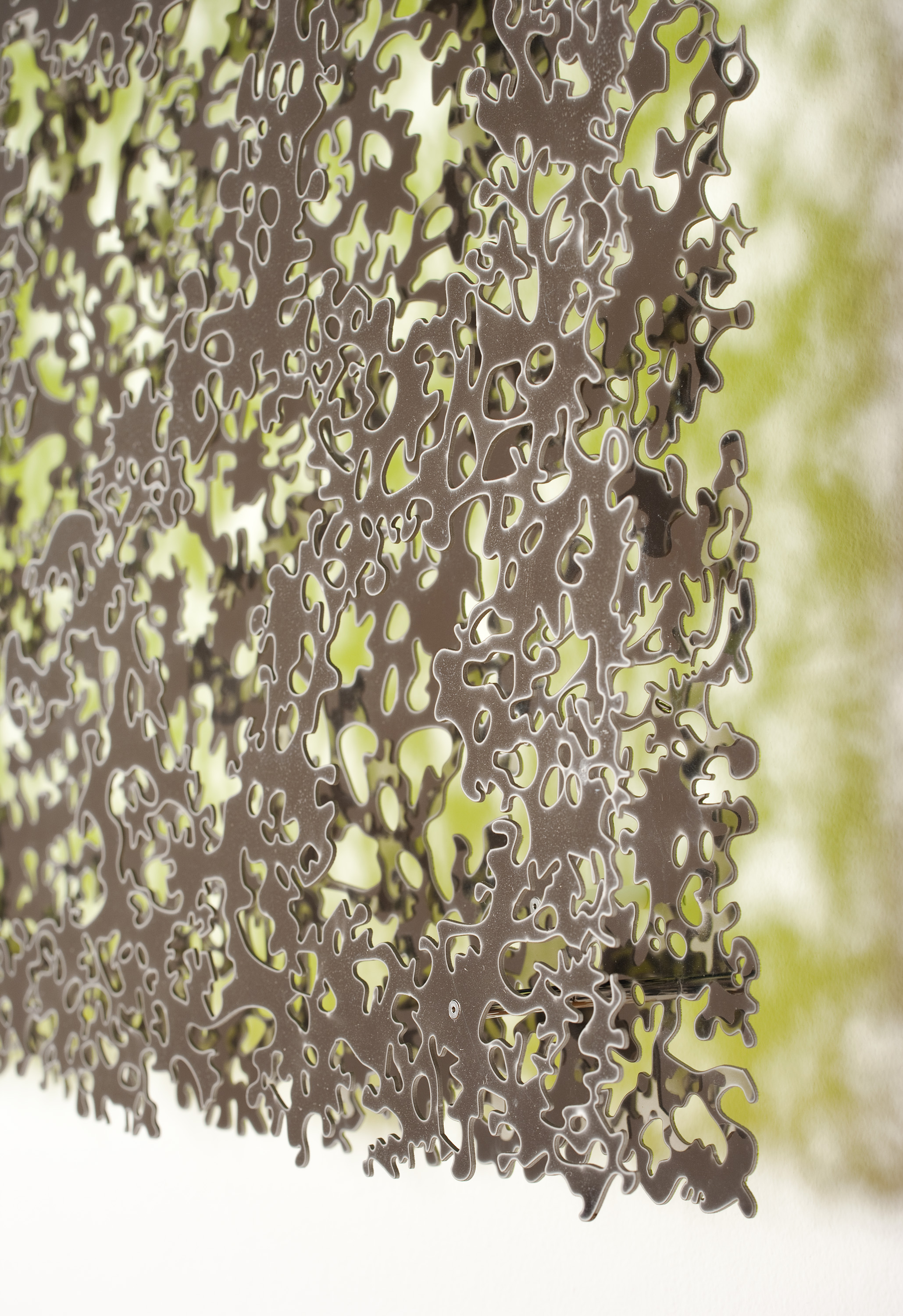
Blind Land (Green Mirror) (detail), 2013. Two layers of polished precision-cut stainless steel, 46.5 x 70.5 inches. Courtesy the artist, and Lehmann Maupin, New York and Hong Kong.
LD: Where do the ideas of transporting viewers somewhere else and transforming their existing surroundings intersect in your work?
TF: The work functions like a prompt. Much like when you’re in the real landscape, half of what you see is in fact what you bring to it. The work asks you to fill in the blanks. Again, I have that reciprocity with the viewer, but the work can’t solely create that affect. There is a kind of willingness to participate, to project onto that thing, to unravel something experientially that’s essential.
I’m often interested in mined materials—materials from particular places. For example, the graphite I’ve used is from Sri Lanka. I’ve used gold, pyrite, and iron ore. These materials are literally parts of places. They’re physically extracted from particular places—in that sense part of a real landscape. When I create a new image using these raw materials, it becomes loaded with being more than one thing at once. It becomes simultaneously the landscape it came from as a material, but also the secondary image that’s created, which may be entirely different and unrelated. So I’m playing with this notion that we’re always in many places at once and that each place that we think of is really a sort of layering, a stacking, of many places, whether they’re physical, or imagined, or remembered.

Viñales (Reclining Nude), 2015. Wakkusu ® Concrete, bronze, and malachite, 48 x 64 x 101 inches. Courtesy the artist, and Lehmann Maupin, New York and Hong Kong.
LD: A lot of your sculptures invert ideas about their subjects—Waterfall is almost industrialized in its singular output, while Dune is a staircase you climb into not on top of. It seems the natural elements your work explores require a human presence to be fully understood. In what ways do you see humans as a perpetually present part of landscape itself?
TF: If you look at ancient Chinese landscape ideas, they’re not separate from the viewer. It’s not like you’re in the landscape or you’re a privileged entity viewing what’s around you. You’re more of an integrated component of landscape. I’m really interested in the sort of reciprocity of that; you are simultaneously looking at the landscape, but the landscape is also looking at you. In fact you are also creating that landscape, you’re an active part of what that is. I employ these ideas in my work when I make a site-specific installation, or when I make a body of work that’s a reference to a specific place. Not only am I interested in the physical coordinates of place, but in this notion that we are always very actively placing and looking for ourselves, repositioning ourselves within place. Again, the idea of landscape isn’t this fixed idea, it’s more a sense that we’re constantly negotiating and redefining by our presence in it. It becomes a way of looking at place as both a verb and a noun simultaneously. So you have a physical place but you’re also actively placing yourself within place.
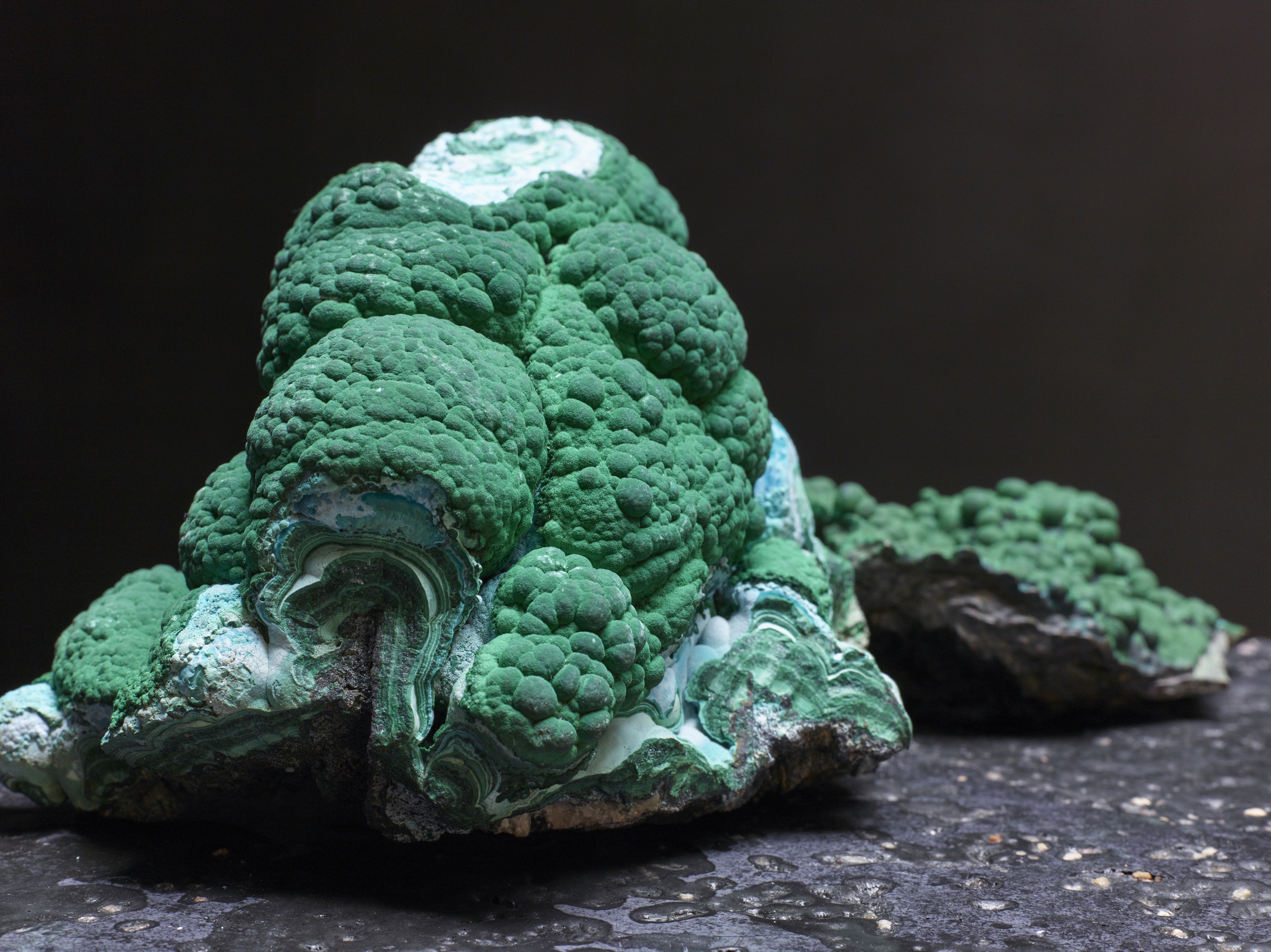
Viñales (Reclining Nude) (detail), 2015. Wakkusu ® Concrete, bronze, and malachite, 48 x 64 x 101 inches. Courtesy the artist, and Lehmann Maupin, New York and Hong Kong.
LD: Can you talk a little about your process of creating site-specific installations? What aspects of a place are you most attuned to?
TF: When I do something site-specific is I ask myself, “Where am I?” It’s this very simple question but it’s also a very loaded question depending on how you ask it. Because histories are very contradictory and skewed, I often ask myself that question about place: Where am I historically, physically, socially, geographically, racially? Where are these coordinates? What’s around me? What happens if I dig a hole three-hundred feet down, what would I find? What’s above me? This notion that the landscape is behind your head as well and underneath your feet and above your head—rather than something we only experience frontally—means that you also move through places as they in turn move through you.
I’m looking at place not just as physical place, but as imagined place—really thinking about places and landscapes as the history of human beings, rather than as these static sites. A landscape from one century to the next can look completely different, certainly if it’s near urban environments. And for the most part many aspects of the history of a physical site can remain completely invisible to a present-day viewer.
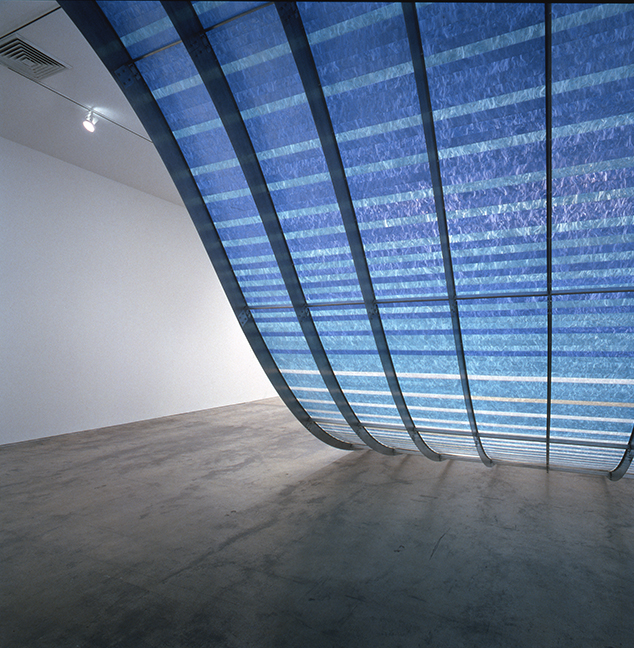
Waterfall, 2000. Aluminum, plastic, 144.09 x 144.09 x 335.83 inches. Courtesy the artist, In Arco, Torino and Lehmann Maupin, New York and Hong Kong.
LD: Many of your works refuse the definitions of a start and end point, but Fata Morgana gave viewers a clear entry, a place where they became part of the work. In your public installations, at what point do you see people transitioning from passersby to viewers to part of the artwork itself?
I think of all of those three as interchangeable. With Fata Morgana (2015) in Madison Square Park, over fifty thousand people a day walked through that park and under the piece. Regardless of whether they were choosing to or not, they became projected onto the piece and they also became projected onto a shared space with other commuters and passersby. In the case of that particular project there was a democratizing effect to how I used the public realm and public space, and it meant that as a passerby you were the viewer and you were also the artwork. The artwork wasn’t the metal, or the steel, or the footings, but rather the dynamic surface created by people interacting with it and the shifting light. So from one moment to the next, the piece could look entirely different. The project was almost like a barometer to the space and shifting atmospheric conditions and light and everybody around it. It was like one gigantic mirror to the site itself and to the urban activity of New York City.
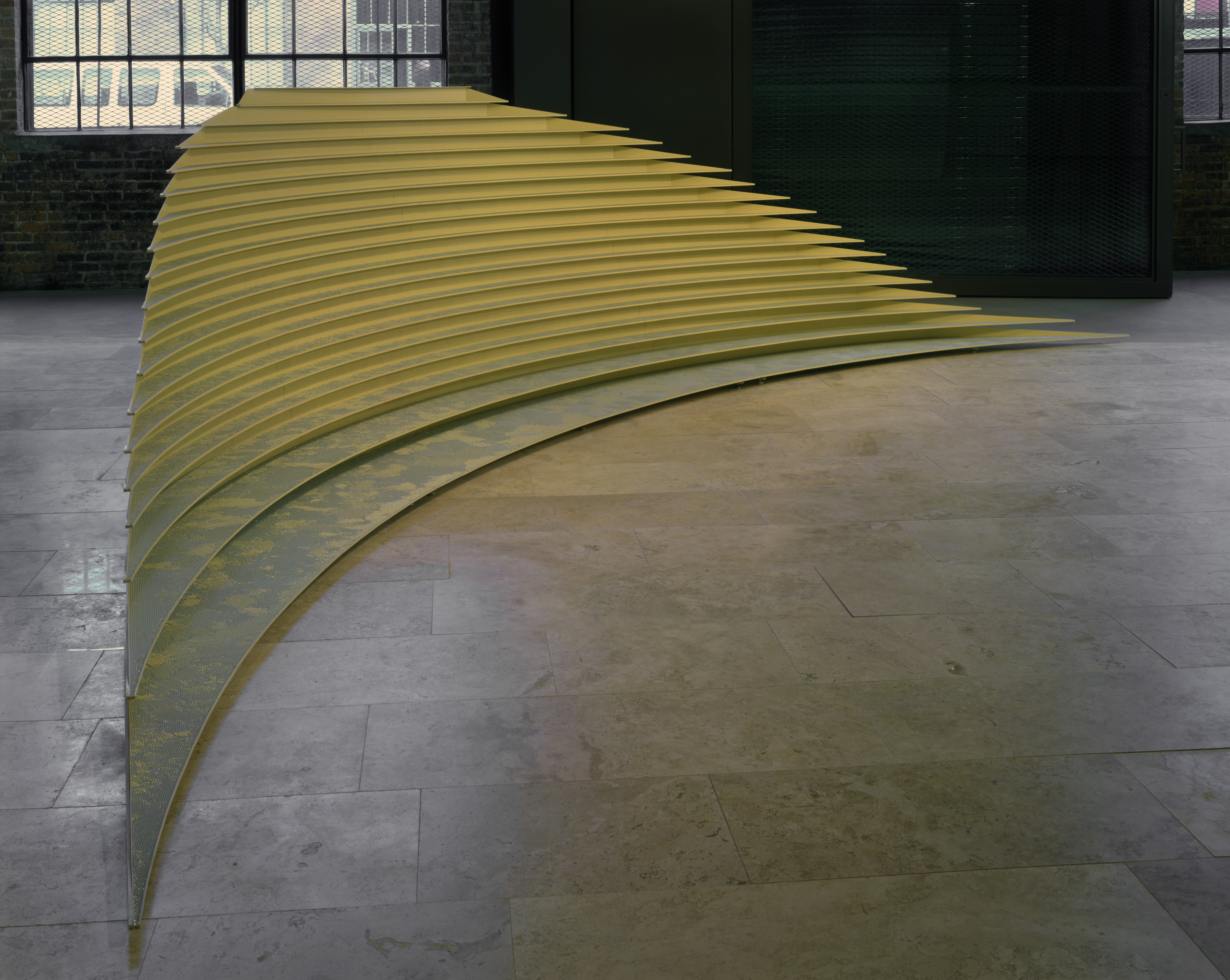
Dune, 2002. Painted aluminum, glass beads, 336 x 60 x 96 inches. Courtesy the artist, and Lehmann Maupin, New York and Hong Kong.
LD: Your work consistently weaves cultures and locations together and yet somehow seems to represent all of them. What places have you visited that especially struck you, that you knew you had to include an element of in your work?
TF: I’ve been traveling a lot since early on in my career. I spent a long time just doing residencies in different places, so Japan of course is a very important place to me, and a lot of my formation about the landscape, but also about intimacy, I think came from my time in Japan. There are some specific landscapes that are important to me because I’ve spent time there. Bali is an important place for me; Cuba is an important place because it’s where my family comes from. It’s a historically very rich landscape full of complex human narratives.
The artwork is not meant to be an illustration of those places. In fact I have a very universal sensibility about places. One of the most interesting things about being an artist is that my work is based on this very strange way of linking and making connections between things that normally would have nothing to do with one another. There’s a kind of universality in the work, so that in the same thing I could be referencing a very European image or idea, layered with something that came from a very Japanese experience, with a historical piece of American literature that I read in something else. And there’s no hierarchy to these references because I’m not illustrating any one of those things, I’m actually drawing connections between them in ways that are unconventional and through a very personal lens.
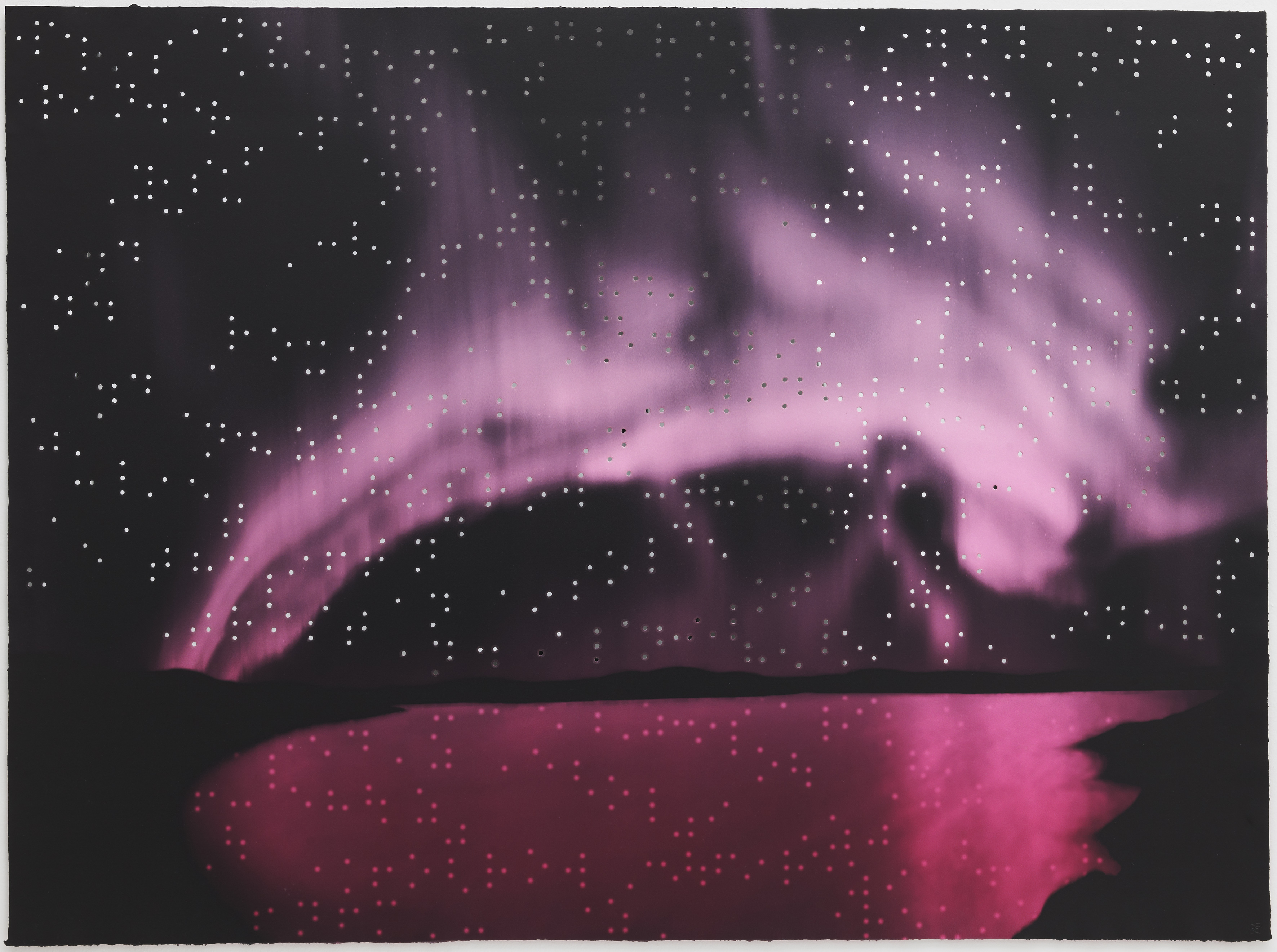
Night Writing (Hero and Leander), 2011. Colored and shaped paper pulp with ink jet assembled with mirror, 49.21 x 66.14 inches. Courtesy the artist, Lehmann Maupin, New York and STPI Singapore.
LD: So would you say it’s not so much a single experience that you have in a place that drives your work?
TF: Sometimes it’ll be one very strange fact about a place, like Borrowdale, England, for example. My sculpture Drawn Waters (Borrowdale) (2009) is a reference to Borrowdale, England, which is the place where graphite was discovered in the 1500s. That one fact, the idea that pencils, and therefore drawings came, literally, from this landscape that was just solid graphite underground. The idea that the pencil that you draw with could come from a physical landscape, where you could stand on that landscape and everything underneath your feet would be solid graphite, became another way for me to think about the act of drawing.
Sometimes it’ll just be one very quirky detail that attracts me to a particular landscape. What becomes important isn’t the big overt characteristics, but rather the quirky detail that relates to something else, at least in my mind. In hindsight, after I make the work and I draw those connections, I am giving a form and sensibility to them. But beforehand, it is actually very mysterious and complex to draw those connections between things and places—that’s the inventive, conceptual and challenging part of my process.




Pingback: Unexpected Readings – Hannah Watters: MFA Project